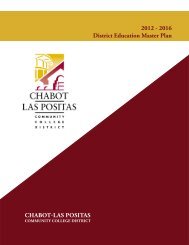City College of San Francisco - California Competes
City College of San Francisco - California Competes
City College of San Francisco - California Competes
Create successful ePaper yourself
Turn your PDF publications into a flip-book with our unique Google optimized e-Paper software.
THEME IV<br />
Many <strong>of</strong> the recommendations <strong>of</strong> the study are being implemented and will be documented in the End-<strong>of</strong>-<br />
Year Assessment Report, Program Review, and the Self Study. The Admissions and Records Department has<br />
achieved an impressive level <strong>of</strong> ongoing improvements, whether or not each <strong>of</strong> those resulted from the<br />
re-engineering study, pre-dated it, or was associated with a series <strong>of</strong> discussions by A&R and the consultants.<br />
The bottom line is that these improvements have facilitated student learning by stripping away<br />
“red tape” and allowing students better access to all that the <strong>College</strong> has to <strong>of</strong>fer.<br />
Financial Aid: Focusing Institutional Attention. In the structure <strong>of</strong> the <strong>College</strong>, Financial Aid is part <strong>of</strong><br />
the Student Development Division. Financial Aid has an impact directly affecting over 10,000 students<br />
per academic year. The Financial Aid story begins in the early 1990s with a department that by all<br />
accounts was in a state <strong>of</strong> crisis.<br />
That crisis had many dimensions. Without belaboring the negatives, suffice it to say that the Financial<br />
Aid Office at that time fielded a constant litany <strong>of</strong> student complaints, suffered from extremely low staff<br />
morale, was not making use <strong>of</strong> all available technologies, and experienced a very heavy backlog <strong>of</strong> cases.<br />
The flexibility <strong>of</strong> the <strong>College</strong> Planning and Budgeting System, in putting outside resources to the service<br />
<strong>of</strong> internal improvement, has been responsible for a considerable turnaround in this area. A complete<br />
redesign <strong>of</strong> services was stimulated by student satisfaction survey data, followed by a performance audit<br />
by an outside entity, all with the full support <strong>of</strong> the <strong>College</strong> Planning and Budgeting System. Improving<br />
Financial Aid was a top priority.<br />
The Chancellor describes Financial Aid as “a tangible and critical part <strong>of</strong> the <strong>City</strong> <strong>College</strong> welcome<br />
mat—an essential element <strong>of</strong> the <strong>College</strong>’s role in access and equity in higher education.” There is data<br />
to support that claim: ongoing surveys by CCSF <strong>of</strong> local high school juniors and seniors indicate that<br />
about 25 percent <strong>of</strong> local students aspiring to college see finances as a significant barrier, one that actually<br />
causes them not to enroll. Providing information about available financial aid greatly helps to level the<br />
playing field for low-income students, including many in underrepresented groups.<br />
In the early 1990s, CCSF was not succeeding in leveling the playing field as well as it hoped to. In fact,<br />
as early as 1995, Financial Aid at the <strong>College</strong> was acknowledged as an <strong>of</strong>fice in deep trouble, although the<br />
path to improvement was far from clear. Student and employee surveys showed low levels <strong>of</strong> satisfaction<br />
with the Office, which had been put on Watch Status in its 1995 Program Review. There was concern<br />
that students were not getting timely and complete information about the availability <strong>of</strong> financial aid,<br />
and were not getting the high-quality service they had a right to expect when applying for aid. There<br />
were unsuccessful attempts to improve the situation; these apparently did not address the multiple roots<br />
<strong>of</strong> the dysfunction.<br />
Planning. In 1998, under the Chancellor’s leadership, the <strong>College</strong> began to take a more systematic<br />
approach to resolving the problems in the Office. While the 1997 Strategic Plan was still in force, a routine<br />
review <strong>of</strong> the implementation status <strong>of</strong> the Plan resulted in a planning update document, including plans<br />
for improvements to Financial Aid. Strategic planning seemed the best vehicle in terms <strong>of</strong> the internal<br />
planning system for making key improvements in the Office, but it was felt that seeking outside advice<br />
to inform strategic planning in this area would be the smart thing to do.<br />
300 CITY COLLEGE OF SAN FRANCISCO







